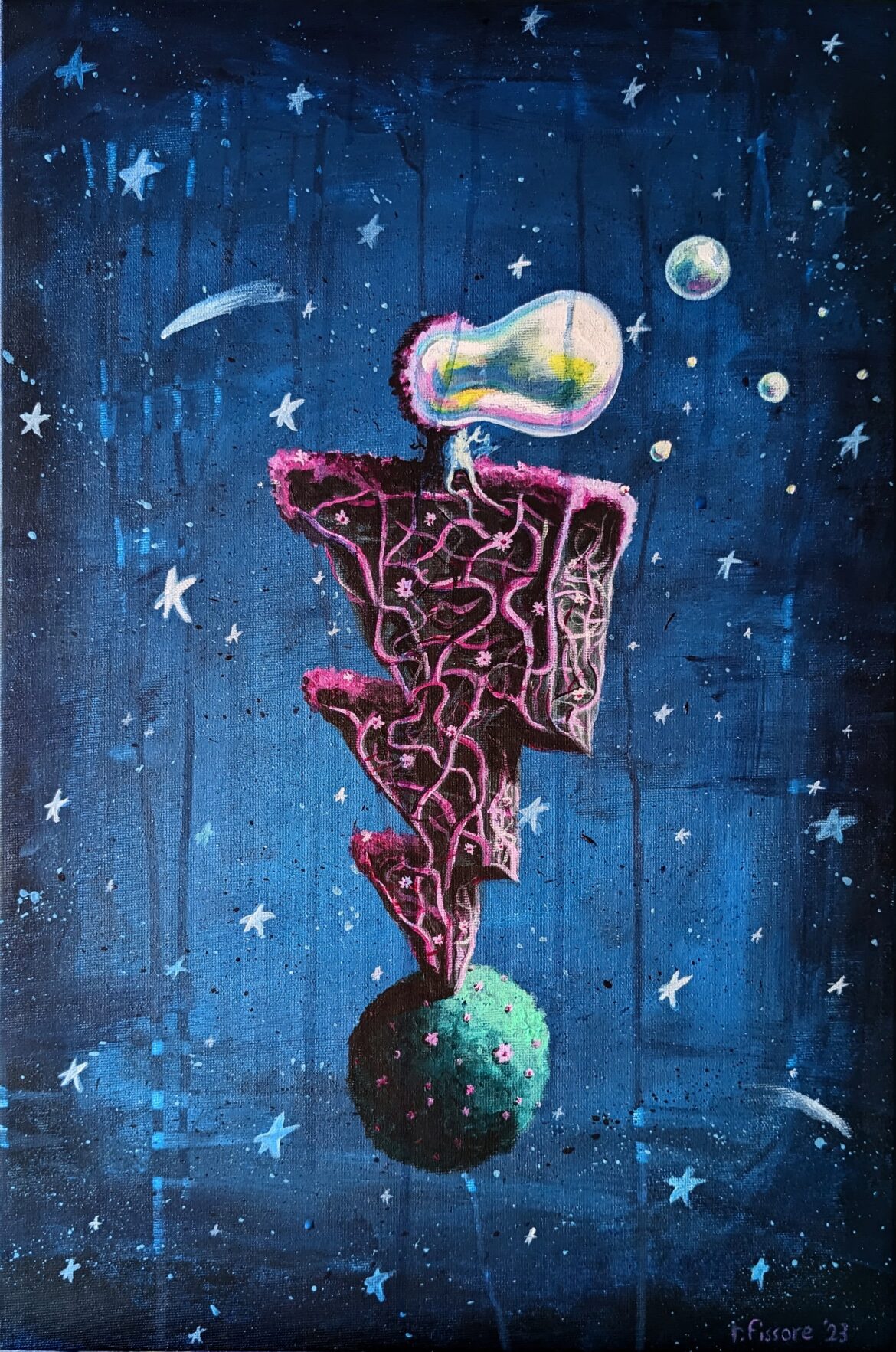Autore
Indice
- Introduction
- Contingency and necessity
- Comparison of Nobel Prize Winners: Jacques Monod and Christian De Duve
- Debate between Ernst Mayr and Carl Sagan
- Contemporary scientists: Paul Davies and Caleb Scharf
- Conclusion
↓ download pdf
S&F_n. 30_2023
Abstract
Contingency and Necessity in the debate on the abundance of life in the cosmos
One of the most contested issues in astrobiology pertains to the prevalence or rarity of life in the cosmos, ranging from the most elementary to the most complex and intelligent organisms. With limited empirical evidence, responses and presumptions among scholars often diverge considerably or are contradictory. This article aims to show how the categories of contingency and necessity influence the conclusions drawn by some authors, which are often polarised, and why it would be useful to rearticulate them in a less dualistic way. The article will commence by defining these concepts, then analyse the positions of Nobel laureates Jacques Monod and Christian De Duve, examine the comparison between Ernst Mayr and Carl Sagan, and finally focus on two contemporary scientists, Paul Davies and Caleb Scharf. The analysis shows that the scarcity of life often correlates with the numerous contingent factors involved in its origin and evolution. In contrast, abundance is linked to the factors that constrain life to a strictly necessarily path. Those who propose less extreme solutions will show a more flexible approach in the use and articulation of these categories, which are not clearly opposed. Finally, we will examine their utility in the debate and why it may be beneficial to utilise them in a non-dualistic manner to attain less polarised conclusions.
1. Introduction
The discussion on extraterrestrial life is a highly controversial topic and has often led scholars to take opposing views: some believe it to be highly probable and common, whereas others consider it unlikely and rare. The authors in question use concepts related to those of contingency and necessity[1], and it will be shown how they influence the way we interpret data and draw conclusions.
The history of Western philosophy and science is marked by dualisms, such as mind/body, subject/object, nature/culture, randomness/causality, order/chaos. While these categories are valuable for analysis, they can be misleading, oversimplifying complex phenomena and neglecting nuances[2]. The aim of this study is to demonstrate that polarised use of these categories generates extreme positions, while a less confrontational approach combined with novel categories provides valuable tools for exploring the many possibilities that lie between the extremes of abundance and scarcity of life in the cosmos.
2. Contingency and necessity
Contingency and necessity have been employed as antithetical terms, linked to other notions with meanings that contradict each other or constitute opposites.
Contingency pertains to the occurrence, to the notion of possibility and therefore of happenstance, accident[3]. If an event has the possibility of occurring or not, then it is not a necessary constraint that determines its occurrence. The occurrence or non-occurrence of the event cannot be explained or traced back to a cause, therefore it is the result of chance and is unexpected. It is worth noting how contingency is related to the concepts of probability and repetition. We use the term contingent to define an event for which we cannot provide a logical explanation, particularly if it does not happen frequently enough to investigate its causes or establish a pattern. Meanwhile, we say of what is rare or improbable that there is no explanation as to why it is so, that it is random and therefore contingent.
Necessity is a concept that pertains to the character, quality, and condition of that which cannot be otherwise[4]. It admits of no other possibility, yet we must be able to provide an explanation for why a phenomenon is one way and not another. Necessity therefore leads back to the concept of cause, of causality, because there are constraints, conditions that determine that something is exactly this way and not another: all this is linked to the concept of determinism. If an event can be traced back to one or more causes, it can be explained, allowing for predictions to be made. For an event to be predictable, it must repeat itself, and the greater the frequency of repetition, the higher the probability. The regularity suggests a response to laws or certain conditions. The concept of order, the possibility of giving an order, a sense, replaces that of chaos[5].
As previously mentioned, these two concepts can have varying interpretations depending on the context. They have not always been opposed to each other and, at times, have even complemented one another or clarified an aspect of the other. It is useful to differentiate between “contingency per se”, which reflects the definition given so far, and “contingency upon”, which is possible in itself but necessary in relation to something else, hence dependent on it[6]. It was taken up by the biologist John Beatty: the difference is that in the version of unpredictability – contingency per se – the occurrence of a particular antecedent state is not sufficient to produce a particular outcome, whereas in the version of causal dependence - contingency upon - the occurrence of a particular antecedent state is necessary (or strongly necessary) to produce a particular outcome[7].
3. Comparison of Nobel Prize Winners: Jacques Monod and Christian De Duve
Two major scientists of the second half of the 20th century, both Nobel laureates, explicitly referred to these concepts and used them to analyse the various empirical evidence for the origin of life: their conclusions about the distribution of living organisms in the cosmos are diametrically opposed and both seem to have been strongly influenced by their conceptual tools.
In 1970, Jacques Monod published the renowned essay Le hasard et la nécessité. Essai sur la philosophie naturelle de la biologie moderne in which he aimed to identify the unique traits of living organisms and the macromolecules that embody each fundamental property. Monod identifies these characteristics as teleonomy and autonomous morphogenesis (ensured by proteins), as well as reproductive invariance (which is the prerogative of DNA). He discusses allosteric enzymes, highlighting that the activation or inhibition of enzyme activity is not strictly dependent on a chemical relationship between the substrate and the ligands; instead, the enzyme activity is reliant on the protein’s structure. Regulatory action is due to the protein, which operates within physiological constraints selected based on coherence and efficacy criteria in relation to the cell or organism.
These performances «which seem to transcend the laws of chemistry, if not escape them»[8], cannot be described by a strictly deterministic model; there is no linear cause-and-effect relationship between the various components of the process. There is no strict chemical necessity, although there are structural constraints that determine the coherence of the organism, and so there is still a degree of necessity dictated by these efficacy criteria. However, Monod delves beyond this contingency, which is dictated by structural coherence (contingent upon), and explores a deeper level of contingency, where chance and indeterminacy govern. Analysis of globular proteins shows that specifying their structure requires more information than actually determining their composition. These processes are epigenetic, and genetic determinism cannot account for them. Moreover, DNA at its level also undergoes random mutations, the consequence of constant disturbances at the microscopic, quantum level, which accumulate progressively, resulting in alterations to the macroscopic structure.
We say that these alterations are accidental, that they occur by chance. And since they are the only possible source of modifications to the genetic text, which in turn is the only repository of the hereditary structures of the organism, it necessarily follows that chance alone is the source of all novelty, of all creation in the biosphere. Pure chance, chance alone, absolute but blind freedom, at the very root of the prodigious edifice of evolution[9].
It is only thanks to the ability of DNA to replicate itself and to maintain its structure unchanged that the living being not only resists external perturbations, but also incorporates them when they occur as replication errors, paving the way for evolution. However, despite the determinism introduced by genes and environmental constraints, for Monod it is always chance that rules, making life and human beings highly improbable. He speaks of pure, free chance, not subject to any constraint, and his reference to quantum mechanics is important because it underlines the impossibility of attributing these changes to a deterministic explanation, of placing them on a necessary path. They are indeterminate, chaotic, a source of novelty, and for Monod, the fact that man has appeared by chance in the infinity of the cosmos means that he is highly improbable, so he combines the concepts of improbability, rarity, scarcity with that of chance, accident.
In contrast, Christian De Duve, a Belgian biologist who published Vital Dust: Life as a Cosmic Imperative in 1995, draws clearly opposite conclusions. He believes that life arose spontaneously from the interaction of small organic molecules, widely distributed throughout the universe (the vital dust), which, given the physico-chemical conditions of the pre-biotic Earth, gave rise to complex molecules. Base pairing arose from chemical events that had nothing to do with information transfer, since molecular replication, the offshoot of base pairing, was a side effect of prebiotic chemistry. Each step in the construction of this machinery was the product of deterministic chemical processes, modulated by selection.
For De Duve, during the prebiotic phase, contingency is excluded as the products of the reactions between atoms and molecules are solely determined by chemical and physical determinism. Chance therefore enters the history of life on Earth with the onset of replication and the inevitable mutations that disrupt this process: evolution seems to be governed by contingency, since natural selection acts blindly on the products of chance. But he criticizes this position, first of all with an argument about probability: the fact that an event is causal does not necessarily imply that it is improbable, since the cosmic lottery is immense and thus offers countless opportunities for a given random variant to occur often. Moreover, we must bear in mind that evolution does not operate in a world of infinite possibilities, where only a roll of the dice decides which will become reality; there are both genetic and environmental constraints that limit the possible evolutionary paths[10].
De Duve employs the metaphor of the tree of Life to illustrate the concept. The tree’s growth is horizontal, branching out in innumerable directions, where chance plays a role in offering diverse variants and enriching the diversity of organisms. However, there is also a strong vertical direction, driven by internal pressures, where evolutionary and environmental determinisms play a dominant role. If conditions conducive to the emergence of life forms were to be present on another Earth-like planet, it is likely that such life forms would vary to a considerable extent from those on Earth. However, as complexity increases, it is plausible that intelligent human-like beings could arise[11].
The search for exoplanets and indications of extraterrestrial intelligence is, therefore, warranted by what is known about evolution and the abundance of Sun-like stars present in the universe. It is improbable that we are the sole beneficiaries of the many conditions favouring the emergence of intelligent life.
My conclusion: We are not alone. Perhaps not every biosphere in the universe has evolved or will evolve thinking brains. But a significant subset of existing biospheres have achieved intelligence, or are on the way to it, some, perhaps, in a form more advanced than our own[12].
De Duve does not view chance as a random and unpredictable force. Instead, random genetic variants are subject to both chemical constraints and environmental factors that favour the most appropriate variants. It is important to note that a random event is not necessarily improbable. Furthermore, necessary constraints exist that limit the role of chance in the emergence of genetic information and in evolutionary processes. Hence, it is highly probable for life to have originated on other planets through comparable metabolic procedures and controlled by the DNA-RNA-protein triad observed in Earth’s organisms. Moreover, the existence of intelligence is highly likely due to intricate evolutionary development.
4. Debate between Ernst Mayr and Carl Sagan
In 1995, the debate concerning the likelihood of making contact with extraterrestrial civilizations, between Ernst Mayr and Carl Sagan, was first published. Mayr contends that even the most doubtful individual would concede that basic life-forms might have originated elsewhere, due to the abundance of amino acids, nucleic acids and other macromolecules discovered in cosmic dust. However, life as we know it requires a planet with the right conditions to support it, and Mayr believes that the number of planets in the cosmos is immense, but that the criteria they must meet are innumerable. He concludes that the fact that the Earth had all the right environmental conditions for life to arise and persist «this, surely, was a matter of chance»[13]. Furthermore, the author argues that physicists tend to think more deterministically than biologists, who are accustomed to handling random events and numerous variables. Physicists are inclined to believe that the emergence of intelligent life is certain under the appropriate conditions, while others may perceive it as highly improbable.
He recounts the developmental stages of life on Earth, highlighting that although the earliest life forms emerged swiftly, this was not the case for more intricate life forms, particularly those with advanced intellect. The hominid brain only began to evolve in a certain order of mammals in the animal kingdom approximately 3 million years ago, while that of homo sapiens dates back to 300,000 years ago. It was only in the past century that our civilization advanced enough technologically to begin exploring space and transmitting interstellar messages. This leads the author to conclude that the emergence of a highly developed intelligence may not be favoured by natural selection, given the significant time required for its development and the fact that many animal species thrive without such capabilities, much like our own species has thrived without space technology for a considerable period.
The result is that it is extraordinarily difficult to acquire, because it requires a combination of rare and favourable circumstances, and the success of SETI is «an improbability of astronomic dimensions»[14] because its success depends not on physical or technological limitations but on biological and social factors. So Mayr speaks of contingency in different ways and under different circumstances: first, the fact that the Earth had all the favourable conditions for life is a coincidence, there was no necessity for it to be so; but if another planet also had the same characteristics, this would not mean that intelligent life would emerge, and therefore there is no deterministic process, he accuses physicists of reasoning in these terms. There is no determinism, because the random factors that intervene have to do not only with a “contingency upon” determined by environmental conditions, but also with a “contingency per se”, i.e. with biological and social factors that cannot be foreseen, that depend on completely random, indeterminate circumstances. Rarity and chance, as with Monod, are associated with considerable improbability.
Carl Sagan, on the other hand, believes that there are billions of planets in the cosmos, many of them terrestrial in nature around sun-like stars, and others with a stable abundance of liquid water. Supporting the notion that the inception of life is quite feasible, he highlights that following the Late Heavy Bombardment, favourable conditions facilitated the emergence of the first life forms approximately 3.8 billion years ago. Furthermore, the simplistic creation of organic molecules within the laboratory, using an atmosphere that replicates the Earth’s primitive environment, implies that their formation was initially curtailed by the unceasing destruction they encountered rather than a lack of their production[15].
In terms of intelligence, it is deemed a strategy favoured by nature and manifests itself in various forms and ways. Hence, other sentient beings may differ from humans and have taken similarly improbable evolutionary routes that ultimately led them to develop radio telescopes. He suggests graphing two curves: one for the age of solar-type stars and another for the likelihood of evolving into technologically advanced intelligence. Multiple extraterrestrial civilizations may have emerged at different points and locations. Those who recognized the hazards of asteroids and other cosmic threats must have developed comparable technologies to ours. Sagan assumes that numerous Earth-like planets harbour various life forms, and at least one civilisation per system will attain advanced intelligence and technology.
To him, the emergence of life and development of intelligence and technology depend on favourable circumstances and practical needs, suggesting an environmental determinism and practical necessity.
Nevertheless, he insists on this position, as there is no meaningful evidence to support any claim a priori. We cannot say anything for certain without empirical evidence, which is only obtainable through programs such as SETI. He believes that our biology suffers from extreme provincialism, that life is a solipsism if all living organisms on Earth descend from a common ancestor and we have no other terms of comparison: «There is no aspect of contemporary biology in which we can distinguish the evolutionary accident from the biological sine qua non. We cannot distinguish the contingent from the necessary»[16].
Thus he believes that there are necessary, recurrent biological factors which we must learn to recognise and distinguish from those due to evolutionary contingencies, but only other samples of life will allow us to make this distinction.
5. Contemporary scientists: Paul Davies and Caleb Scharf
At the onset of his 2010 book, The Eerie Silence, Paul Davies, a contemporary astrophysicist, notes that some scientists view life as either a strange accident (F. Crick, G. Simpson, J. Monod) or an inevitable occurrence in the vast cosmos (C. De Duve, A. Boss). He believes that it would be easier to disentangle these two opposing views if we had a clearer picture of how life arises from non-life, and where and how abiogenesis occurred.
I already mentioned that there is no discernible pattern in the sequences of amino acids in proteins. The same goes for the sequences of base-pairs – the ‘genetic letters’ – in DNA. It all looks random. If the laws of physics and chemistry are somehow conspiring to fast-track matter to life against the raw odds, it’s not showing up in the end product – the molecular structures themselves[17].
Similar to Monod’s observations, it is noted that fundamental biological components display a lack of responsiveness to physics and chemistry laws despite the fact that biological activities appear to be both arbitrary and exceptionally accurate. The sequences of amino and nucleic acids do not adhere to consistent mathematical patterns and do not exhibit preferences, however, a slight alteration to the sequence can have grave implications for the functional integrity. Darwin’s evolutionary principle operates at the elementary level by preserving the most suitable changes, those that work best within the system. Davies argues that it is not necessary to conclude that life emerges only once by chance and develops without any rules, due to these random factors. Living entities may abide by a law that is not universally applicable but instead only to specific complexes of emerging intricacy. Consequently, if chance were to give rise to such a particular system, said law could direct it towards life.
The same cannot be assumed for highly sophisticated lifeforms and advanced societies. Drake’s equation highlights several parameters about which little is known, including the proportion of planets on which life arises and those where it develops intelligence. While a civilization may collapse due to natural calamities or self-inflicted disasters, this would be a chance occurrence with no certainty and thus impossible to predict. To address this issue, the author concludes by electing to adopt “three hats”: as a philosopher, he wonders what such a vast universe is for, if only man can witness it; as a human being, he expresses a hope that life and intelligence are welcome in the cosmos; as a scientist, he remains open to new evidence, but if you try to do a probability calculation and assign a value to the various arguments, it tends to conclude that we are the only intelligent beings in the observable universe, and this is because «I see so many contingent features involved in the origin and the evolution of life»[18]. His conclusion is that a definitive answer cannot be given until further empirical evidence is available, but the possibility that chance plays a significant role in the development of life leaves him highly sceptical.
Astrophysicist Caleb Scharf’s book, The Copernicus Complex. Our Cosmic Significance in a Universe of Planets and Probabilities, aims to evaluate the role and significance of the human species in the cosmic landscape. The scientific revolution and subsequent discoveries in astronomy and biology during recent centuries have led to the acceptance of the Copernican principle within the scientific community. This principle posits that there is no center in the universe, and as such, there are no observers whose point of view is privileged. Therefore, humans hold a mediocre, unremarkable position within the cosmos. Scharf wonders whether this principle has not become a complex, and whether the Earth and living organisms such as humans are not a rarity in the cosmos. An analysis of the other known celestial bodies shows that: the orbits of the planets in our system deviate by a maximum of 10% from their circumferences, while 8 out of 10 of the known exoplanets exceed this percentage and a quarter of them reach more than 50%; on the other hand, 75% of the stellar classes are stars with less than half the mass of the Sun, and most planets revolve around these red dwarfs. The abundance of planets confirms the Copernican principle, but their diversity complicates matters, and there is even evidence that the Earth is not so typical. However, hasty conclusions should be avoided, as the behaviour of planetary systems is not rigidly predictable or uniform, as demonstrated by the n-body problem. Given two or more bodies, their initial positions and speeds, it should be possible to predict their future movements with some accuracy; but even with three bodies this is not possible, we are faced with systems that are susceptible to small variations, for which there is no linear correspondence between them and their effects. These are planetary systems, chaotic in the sense that a detail can upset their structure, making it difficult to predict future configurations:
Some of the answers are undoubtedly to be found in general physics, in the laws of gravity at work on the gas and particles swirling around a new-born star that has just emerged from the icy soup of interstellar material. But a considerable part of the puzzle seems to be made by sheer chance. Astronomers speak of planet formation as a stochastic process: even if the events taken individually are physically predictable, the end result is inherently non-deterministic[19].
It is not possible to accurately predict the future evolution of a planetary system, because the final outcome is determined by the smallest variations, which have to do with contingent data. But for Scharf, the final state reached after a series of random and improbable events is not necessarily a rarity; we could be a unique case among unique cases.
Life seems to be a boundary phenomenon, an interface between domains with defined properties, such as energy, position, dimensional scale, time, order and disorder. Factors such as the stability or chaotic nature of planetary orbits, climatic variations, geophysical unrest and so on are direct manifestations of these properties[20]. If we stray too far from the boundary, in one direction or another, the balance is broken and we enter regions that are hostile to life. For Scharf, biology is perhaps the most complicated physical phenomenon, but at the level of reality there is nothing special about it, and it emerges, albeit in a non-linear and easily predictable way, from the laws that are the foundations of physics: these are particularly complicated structures that emerge, when circumstances permit, on the borderline between order and chaos. Our uniqueness is mitigated by the large number of planets and the different paths that life may have taken: we are but representatives of one among many versions of the phenomenon.
6. Conclusion
We have seen that Monod and De Duve explicitly use the categories of contingency and necessity to analyse the empirical data at their disposal: the former privileges the role of chance and concludes that man is alone, rare, improbable, while the latter sees life and intelligence as the product of pathways in which chemical and environmental determinisms predominate. Ernst Mayr appeals to chance both when he has to speak of favourable planetary conditions and when he speaks of random biological and social factors in the history of biological organisms; the unpredictability of the latter implies an improbable chance of success for SETI. Sagan believes that under favourable conditions, life and intelligence emerge out of evolutionary practical necessity, but that only empirical evidence will allow us to distinguish between what is biologically necessary and what is evolutionarily contingent. Davies and Scharf use these categories in a less rigid way: the unpredictability of some biological and social factors still makes Davies skeptical about the existence of other intelligent life forms, but the highly specific performance of biological systems leads him to believe that they may be the product of an emergent law that allows life to evolve where the conditions are right. Scharf illustrates clues that might suggest the rarity of planet Earth, but recognises the stochasticity of planetary systems and believes that the abundance of random factors does not imply improbability; life is described as a phenomenon on the border between order and chaos and, as De Duve suggests, that the cosmic lottery is immense.
In conclusion, we see that each author has been influenced by the categories of contingency and necessity, each understood and interpreted differently. The authors who clearly contrast these categories arrive at extreme positions with regard to the presence of life in the universe, which is either devoid of it (apart from the terrestrial example) or rich in it. On the other hand, those who do not rigidly attribute contingency to unpredictability, rarity, improbability, and vice versa necessity to determinism, abundance, probability, try to articulate these elements (on the border between order and chaos), use new categories (emergent law), arrive at less polarised conclusions.
Therefore, using analytical tools in a rigid and contrapositive manner[21], introducing new categories, can allow the extreme complexity of living organisms to be analysed with greater flexibility. Living organisms are not simply constrained by environmental or genetic determinisms, or subject to external or internal contingencies and perturbations, but are complex systems with an autonomy that is always subject to the vagaries of the environment, but also capable of resisting them[22]. There is an enormous range of possibilities between zero and a great deal of life, which we should be able to explore with categories that are not metaphysical prejudices but useful tools of analysis.
[1] R.M. Hazen, Chance, necessity and the origins of life: a physical sciences perspective, in «Philosophical Transactions of the Royal Society», A375, 20160353, 2017, pp. 1-12: 2.
[2] E. Morin, La sfida della complessità (2011), tr. it. Le Lettere, Firenze 2017.
[3] N. Abbagnano, Dizionario di filosofia, UTET, Torino 1971, pp. 168-169.
[4] Entry “necessità” in “dizionario di filosofia” available on the site Treccani: https://www.treccani.it/enciclopedia/necessita_%28Dizionario-di-filosofia%29/
[5] E. Morin, La méthode. La nature de la nature, Seuil, Paris 1977, p. 74.
[6] R. Audi, The Cambridge Dictionary of Philosophy, Cambridge University Press, New York 2015.
[7] J. Beatty, Replaying Life’s Tape, in «The Journal of Philosophy», 103, 7, 2006, pp. 336-362: 339.
[8] J. Monod, Le hasard et la nécessité. Essai sur la philosophie naturelle de la biologie moderne (1970), Éditions Points, Paris 2014, p. 104.
[9] Ibid., pp. 147-148.
[10] C. De Duve, Constraints on the Origin and Evolution of Life, in «American Philosophical Society», 142, 4, 1998, pp. 525-532: 528-529.
[11] C. De Duve, The evolutionary lottery, in The Scientific Legacy of the 20th Century, edited by W. Arber, J. Mittelstrass, Pontifical Academy of Sciences, Acta 21, Vatican City 2011, pp. 181-189: 187.
[12] C. De Duve, Vital Dust. Life as a Cosmic Imperative, Basic Books, New York 1995, p. 297.
[13] E. Mayr, C. Sagan, The search for extraterrestrial intelligence: scientific quest or hopeful folly?, in «The planetary report», 8, 3, 1996, pp. 4-13: 6.
[14] Ibid., pp. 4-13: 7.
[15] C. Sagan, The Origin of Life in a Cosmic Context, in Origins of Life, vol. 5, Reidel Publishing Company, Dordrecht 1974, pp. 497-505: 499.
[16] Ibid., pp. 497-505: 497.
[17] P. Davies, The Eerie Silence. Are we alone in the universe?, Penguin Books, London 2010, pp. 65-66.
[18] Ibid., p. 314.
[19] C. Scharf, Il complesso di Copernico. Il nostro posto nell’universo (2015), tr. it. Codice Edizioni, Torino 2015, p. 115.
[20] Ibid., pp. 218-219.
[21] R.M. Hazen, op. cit., p. 1-12: 7.
[22] E. Morin, La méthode. La vie de la vie, Seuil, Paris 1980.








